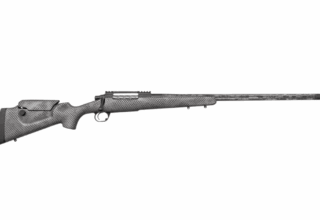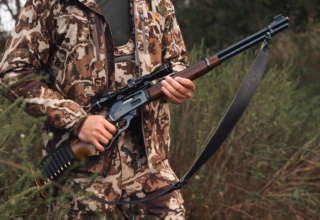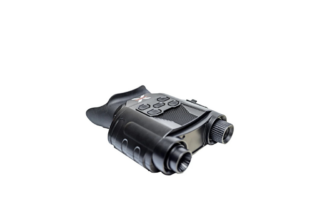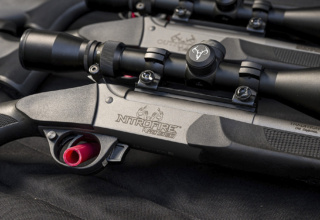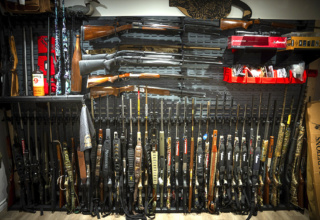Trucks, planes, and boats can all be part of a day’s travel to access the game-rich corners of Saskatchewan. Whether you’re chasing white-tailed deer, black bear, moose, upland game birds, or the renowned waterfowl at the top of the central flyway, Saskatchewan offers some of the best hunting in the world.
What avid hunter doesn’t have a bruiser whitetail or limits of ducks and geese on their hunt bucket list? A quick look through the Boone and Crockett records will certainly attest to the quality of antlers and skulls being produced in this diverse province.
Know Where You Go
Saskatchewan has a vast prairie region in the south, with extensive agriculture, and huge expanses of boreal forest and Canadian Shield in the north. The province is large by most standards, covering 251,700 square miles. Whether you’re a waterfowl hunter or someone who wants to hunt moose, knowing that 10 percent of Saskatchewan is fresh water, composed mostly of rivers, reservoirs, and the province’s 100,000 lakes you know why the province is a consistent producer of wildlife.

Saskatchewan is bordered on the west by Alberta, on the north by the Northwest Territories, on the east by Manitoba, and to the northeast by Nunavut. The south border is shared with Montana and North Dakota.
As of late 2017, Saskatchewan’s population was estimated at 1,163,925 meaning there is little resident hunting pressure. There are almost as many licensed hunters in the state of Pennsylvania as there are people in Saskatchewan, and when you consider the state is just over 46,000 square miles in size with close to 13 million people, it isn’t hard to understand why this province is a hunter’s gem.
Saskatchewan receives more hours of sunshine than any other Canadian province, allowing farmers to grow productive crops. The boreal forest is one of the most productive regions in the world, contributing between 3 to 5 billion birds to fall migrations out of the boreal after nesting season each fall. Over 80 percent of the continent’s waterfowl nest in the boreal region and the majority of them funnel through Saskatchewan on their fall migration.
Waterfowl
 Saskatchewan boasts close to 23,000 square miles of fresh water, with rivers, lakes, and reservoirs. Add the incredible number of small wetlands across the prairie, and it isn’t hard to understand why the province is a waterfowl Mecca, both in production and staging. The productive wetlands in the agricultural region of Saskatchewan are considered by many to be the most important waterfowl breeding area in North America. Consider the fact that up to 70 percent of the North American waterfowl population migrates through Saskatchewan, and there should be no doubt where you need to plan your next trip.
Saskatchewan boasts close to 23,000 square miles of fresh water, with rivers, lakes, and reservoirs. Add the incredible number of small wetlands across the prairie, and it isn’t hard to understand why the province is a waterfowl Mecca, both in production and staging. The productive wetlands in the agricultural region of Saskatchewan are considered by many to be the most important waterfowl breeding area in North America. Consider the fact that up to 70 percent of the North American waterfowl population migrates through Saskatchewan, and there should be no doubt where you need to plan your next trip.
There is a professional network of waterfowl outfitters, offering all the bells and whistles to deliver the Canadian dream hunt to traveling waterfowl enthusiasts. Hunting the agricultural fields for mallards, pintails, honkers, specklebellies, Ross’, and snow geese, Saskatchewan provides outstanding results. If you like divers, there are staging populations of goldeneye, canvasback, and redhead that would boggle the minds of avid marsh rats.
There are outfitters across the southern reaches of the province offering all-inclusive packages, with everything from pick up at the airport to lodging, meals and bird processing. All you need to show up with is your clothes, and if you prefer to shoot your own shotgun pack it along too.
With most waterfowl species showing above average populations, there has never been a better time to plan a waterfowl trip.
Upland Birds
 There are incredible upland game bird hunting opportunities throughout Saskatchewan. The southern farm country is home to sharp-tailed grouse, Hungarian partridge and ruffed grouse. The boreal forest also offers ruffed and spruce grouse, and if you get far enough north, ptarmigan are also available.
There are incredible upland game bird hunting opportunities throughout Saskatchewan. The southern farm country is home to sharp-tailed grouse, Hungarian partridge and ruffed grouse. The boreal forest also offers ruffed and spruce grouse, and if you get far enough north, ptarmigan are also available.
Fully outfitted hunts offer incredible wing shooting over trained dogs that see lots of action. Most outfitters offer a full-package hunt that will send you home feeling spoiled.
White-tailed Deer
I doubt there is a deer hunter alive that hasn’t dreamed about hunting the big whitetails of northern Saskatchewan. The deer are legendary for their body size and the incredible bone mass they grow on their heads.

The Hanson Buck shot near Biggar, Saskatchewan, scored as a typical whitetail at 213 5/8 inches is a good example of what genetics and survival-of-the-fittest evolution can produce in terms of big-bodied deer that need to survive the harsh weather and elements. One look through any deer record book will show why Saskatchewan is the ultimate dream location for whitetail hunters.
Outfitters offer archery, muzzleloader, and general firearm hunts starting in September and running into December. Most of the deer hunting takes place in the boreal forest, or on the northern fringe of farmland, where the deer have the best feed and large tracts of cover. Outfitters watch and pattern deer year-round and know where the big boys live, or where they tend to show up during the rut. Heated blinds are often used, and the more adventuresome can play the elements from a treestand or spot-and-stalk hunt.
There are lots of outfits with great accommodations, which are often on a scenic lake where you could also test your angling skills. Doing some homework on the different outfitters can put you in a rustic cabin or a fancy lodge, depending on what you’d like from your experience.
Moose
Northern Saskatchewan is best described as a giant block of moose habitat. The boreal forest and Canadian Shield provide ideal browse and thermal cover for moose to grow old. With over 100,000 lakes, there is an endless supply of shorelines to hunt and try to call in old Bullwinkle.

Many outfitters operate out of camps used for fishing clients in the summer. All the conveniences of home make for a comfortable hunt in wilderness areas. For the hardcore hunters, a wall tent camp might suit your fancy, giving the fit and feel of an old-style hunting trip, where you might even break out the red and black wool jacket and pants.
Most outfitters target moose during the rut, allowing them to cover large areas with vocalizations that bring the moose to the hunter. There is nothing more exciting than hearing the grunts of a big bull coming to court the lonely cow call that enticed him out of hiding.
Some camps will be accessible by road, but there are lots of options for a fly-in trip to really get you away from civilization.
Black Bear
Northern Saskatchewan is one of the few jurisdictions that run a spring black bear season until the end of June. If you know anything about bear biology, you’ll know they rut in late May through June, giving hunters the opportunity to catch a big, old boar roaming the remote corners of its territory.

Baited hunts generate lots of action, and where you have sows, the big bruins are sure to show up. Saskatchewan produces some extremely big bears, with skulls that measure high in the trophy books. Genetics are a big part of the equation, and it is easy to see by the entries in Boone and Crockett that there isn’t a bad place to hunt bear in Saskatchewan.
Bear camps are often remote cabins and fishing camps, and wall tent options are available. There is always a sense of excitement when you must travel by truck, boat, and ATV just to get to camp. It is all part of the adventure that will leave a Saskatchewan bear hunt etched in your memory as one of your best outdoor experiences. Fishing for giant northern pike, walleye, and lake trout is often available to fill the long spring days, where you’re likely to have over 20 hours of daylight to tire yourself out.
If size matters, you may want to consider a fall black bear hunt. Bruins ready to den up for winter are almost twice the size they’d be in the spring. Fat bears with glistening new hides make outstanding trophies and tablefare.
Ask Your Outfitter
Good questions to ask your potential outfitter when looking for an all-inclusive package.
- What are the accommodations and what is the menu for a regular week in camp?
- Are license fees included in the hunt price?
- Is there anything I need to bring besides my hunting tool and clothing?
- Do you have references from clients that have been successful, and those that haven’t?
- What do you offer that other outfitters don’t?
Hunting Information
The 2018 Saskatchewan Hunters’ and Trappers’ Guide is available to download online HERE. Season, license requirements, and costs are clearly outlined for spring and fall seasons.
People born after January 1, 1971 must hold a certificate from a recognized firearm safety/hunter education course to hold or apply for a Saskatchewan game license.
See You in a Couple Hours
A Saskatchewan hunting adventure is just a day away from anywhere in North America. With international airports in Saskatoon and Regina, this prairie province is accessible from anywhere in the lower 48, and you’ll still have time for a AAA Canadian beef steak at a top-notch restaurant, or at a lodge where you might be hunting.
Even the far northern reaches of Saskatchewan have regularly scheduled flights to put the world at your fingertips.

Planning Your Adventure
Tourism Saskatchewan has a great website, where adventure-seeking hunters can explore their options for an all-inclusive, fully-guided package. To check out all the options, go to www.tourismsaskatchewan.com and click on the menu button, then Things to Do, then Hunting Adventures.
The site has all the details for planning a trip and gives you information to access professional outfitters that specialize in the species you’d like to target.
Firearms
There is a misconception that bringing a firearm into Canada is difficult. There are forms available online to make the process easy and efficient when crossing international borders. You can find a fact sheet and the Firearms Declaration Form HERE Click on English, then on Visitors/non-resident. Fill out your forms with the firearms information you will be bringing to Canada, but don’t sign it until asked by a Canada Border Agency officer. Hunters can bring two firearms with them, which does not include handguns.


